1 An Overview of the Control Panel on Your Electrolux Dishwasher
Electrolux dishwashers feature an intelligent control panel that allows you to easily adjust functions and select washing programs efficiently. Let’s explore the important control buttons on your machine:
- POWER Button: Used to turn the dishwasher on or off. When the machine is on, the indicator light on this button will illuminate.
- Washing Program Selection Button: You can choose from a range of washing programs, including:
- – INTENSIVE (for tough stains)
- – NORMAL (automatic wash)
- – ECO (energy and water-saving wash)
- – GLASS CARE (for delicate glassware)
- – QUICK (a rapid wash cycle)
- – RINSE (cold-water pre-rinse)
When you select a washing program, the corresponding indicator light will turn on, letting you know that the desired program is active.
- START/PAUSE Button: This button is used to start or pause the selected washing program. When the machine begins operating, the indicator light on this button will flash.
- Child Lock: For added safety, you can activate the child lock function by simultaneously pressing the GLASS CARE and ECO buttons. The child lock indicator light will illuminate between these two buttons when activated.
- Cycle Status Lights: These lights indicate the current status of the dishwasher. When the machine is in the washing phase, the WASH light will be on, and when it’s in the drying phase, the DRY light will illuminate.
- Salt Level Indicator: This light will turn on when the machine requires additional salt in the salt container.
- Rinse Aid Level Indicator: This light will illuminate when the machine needs more rinse aid in the designated compartment.

Function buttons on the control panel of an Electrolux dishwasher
2 Steps to Efficiently Use Your Electrolux Dishwasher
To use your Electrolux dishwasher effectively and ensure its longevity, follow these steps:
Step 1: First, make sure that your dishwasher always has dishwasher salt and rinse aid when in use. For the initial use of a new dishwasher, you’ll need to add salt to soften the hard water. The salt container is usually located at the bottom of the dishwasher. To do this:
- Before starting the first wash cycle, pour approximately 1 liter of water into the salt container.
- Place the funnel (provided with the machine) into the opening of the container and pour in about 1 kg of salt.
- After adding the salt, close the lid and tighten the screw clockwise.
- Typically, the salt level indicator light will turn off within 2–6 days after refilling the salt container.
- It’s important to start a wash cycle immediately after adding salt (preferably a quick wash program) to prevent damage to the machine’s system.

For the first use of a new dishwasher, you’ll need to add more salt to soften the hard water
Step 2: Load the dishes into the dishwasher, ensuring they don’t block the water spray arms. Pots, pans, and large bowls should be placed at an angle to allow water to drain easily. Avoid placing plastic cups or Tupperware containers on the lower rack to prevent deformation.
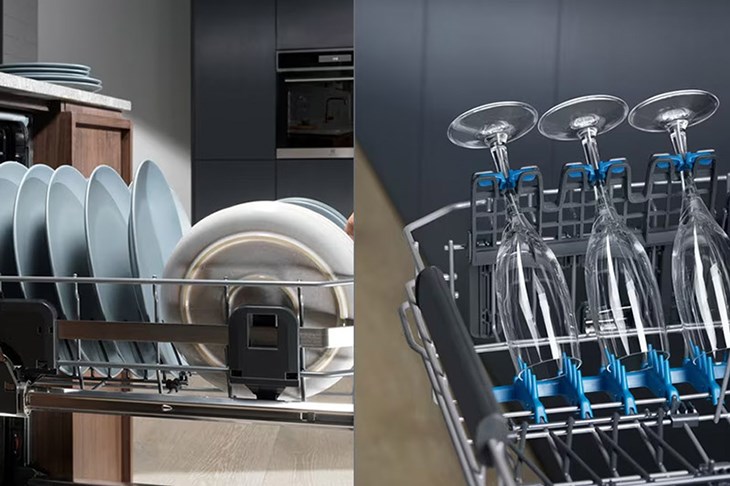
How to properly load dishes, cups, and cutlery into the dishwasher for optimal cleaning
Step 3: Once the dishes are loaded, ensure that the detergent is added to the designated compartment. This can be in the form of detergent tablets or blocks.
For liquid detergent, do not exceed the maximum fill line indicated in the compartment.
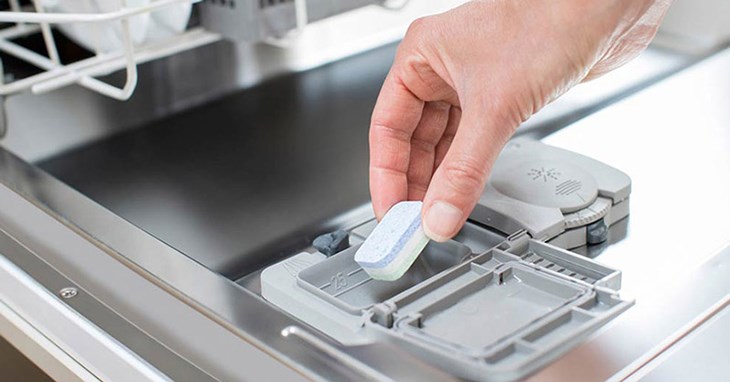
Using convenient detergent blocks
Step 4: To ensure effective cleaning, select the appropriate washing program based on the level of dirt on the dishes. This includes quick wash, intensive wash, and normal wash programs.
- Quick Wash: Uses more water and higher temperatures to clean lightly soiled dishes in a shorter time.
- Intensive Wash: Designed specifically for pots and pans with stubborn stains.
- Normal Wash: Suitable for everyday dishwashing.
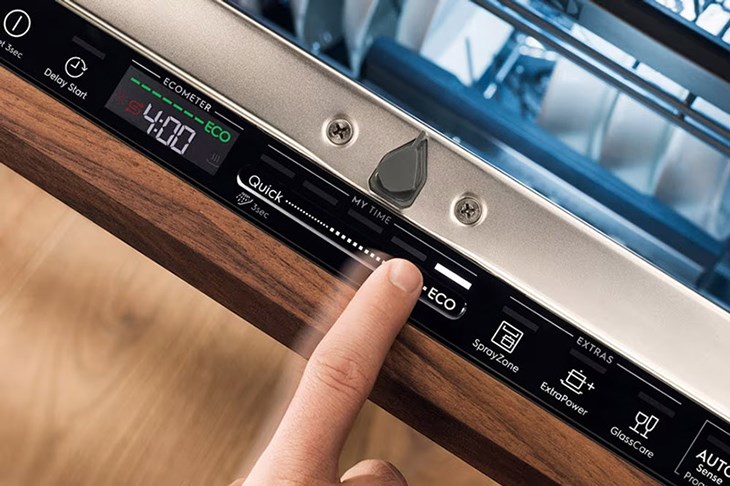
Selecting the right washing program
Step 5: After selecting the appropriate washing program, close the dishwasher door and start the machine by pressing the Start button. Wait until the washing program is complete; the machine will turn off automatically.
Step 6: Once the washing cycle is finished, press the Power button to turn off the machine. Be careful when opening the door, as the dishwasher may still be hot. Wait for about 15 minutes to allow the dishes to cool down before removing them.
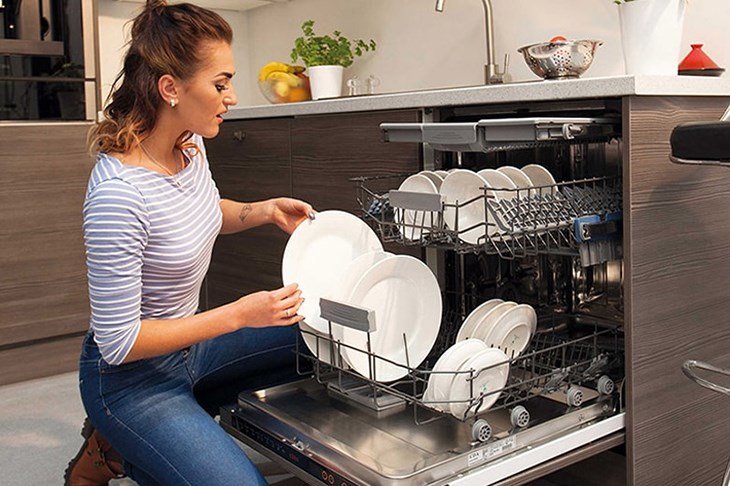
Wait for 15 minutes to let the dishes cool down before unloading
Step 7: To maintain and clean your Electrolux dishwasher, perform the following tasks:
- Wipe the exterior of the dishwasher with a soft, damp cloth and polish it with wax to maintain its shine.
- Clean the dishwasher door with a soft, damp cloth and warm water.
- Periodically clean the spray arms by removing them, rinsing them, and reinstalling them in the dishwasher.

Cleaning and maintaining your dishwasher after use
3 Notes on Using Your Electrolux Dishwasher
Before Washing
- Properly arrange the dishes, plates, and bowls in the dishwasher, facing them inward.
- Place small plastic items in a washing bag to prevent them from falling out and damaging other components.
- Always aim for a full load to save energy and time, and use the appropriate amount of dishwasher detergent.

Properly arranging dishes before washing
During Use
- Pay attention when adding dishwasher salt, ensuring you use the correct amount as per the manufacturer’s instructions.
- Set smart washing times to save time and energy.
- At the end of the washing program, check the dishwasher before opening the door.

Adding the correct amount of dishwasher salt
After Washing
- Dry the dishes, plates, and cutlery after washing to prevent water spots and residue.
- Remove items from the lower rack first to avoid mixing and potential damage.
- When not using the dishwasher for extended periods, follow the manufacturer’s instructions for storage and maintenance.
- When cleaning the dishwasher, adhere to the recommended procedures and advice from the manufacturer.
- When moving the appliance, ensure it is transported and installed correctly to avoid damage and accidental injuries.
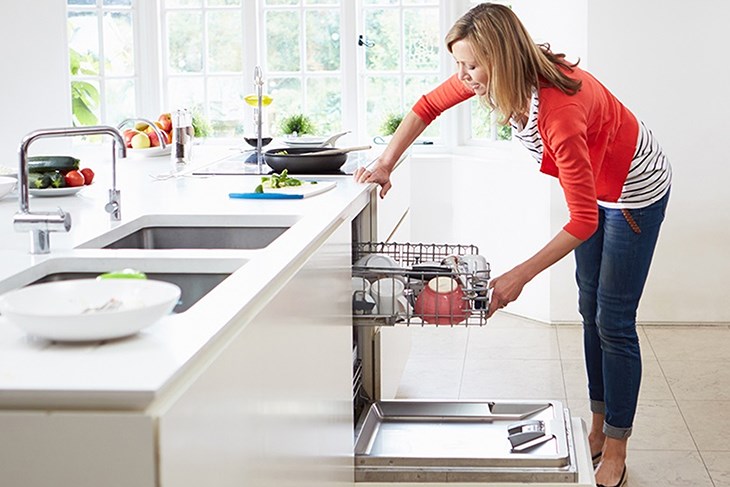
Properly storing and maintaining the dishwasher when not in use for long periods
Exploring the Pros and Cons of Sleeping in an Air-Conditioned Room
Is sleeping with an air conditioner a good idea? As concerns over the adverse effects of air conditioning on our health increase, it’s important to understand the risks and rewards of using air conditioning while sleeping. Let’s examine the benefits and drawbacks of sleeping with an air conditioner, and the protective measures one should take.




































